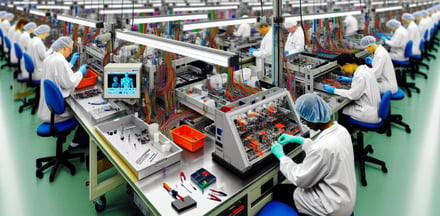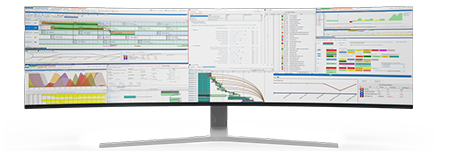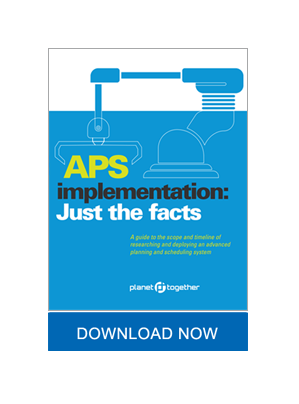Navigating Growth Challenges: Strategies for Production Schedulers
In manufacturing, production schedulers are tasked with a critical responsibility: ensuring that products are manufactured efficiently, meeting demand while maintaining quality standards.
However, in today's volatile operating environment, characterized by fluctuating demand, supply chain disruptions, and evolving regulations, protecting growth rates poses significant challenges. To thrive amidst these complexities, production schedulers must adopt proactive strategies and leverage advanced tools for seamless integration and optimization.
In this blog, we explore how production schedulers can navigate these challenges, particularly through the integration between PlanetTogether and leading enterprise resource planning (ERP) systems such as SAP, Oracle, Microsoft, Kinaxis, and Aveva.

Understanding the Operating Environment
Medical manufacturing operates within a dynamic landscape influenced by various factors, including market demand, regulatory requirements, and technological advancements. The COVID-19 pandemic further underscored the importance of agility and resilience in responding to sudden disruptions. To protect growth rates, production schedulers must anticipate and adapt to these changes effectively.
Challenges Faced by Production Schedulers
- Demand Variability: Fluctuations in demand due to seasonal trends, product innovations, or unexpected events can disrupt production schedules, leading to inefficiencies and missed opportunities.
- Supply Chain Disruptions: Delays in raw material procurement, transportation bottlenecks, or supplier issues can hinder production schedules, impacting delivery timelines and customer satisfaction.
- Regulatory Compliance: Stringent regulations governing the medical industry necessitate adherence to quality standards, documentation requirements, and compliance protocols, adding complexity to production scheduling processes.
- Resource Constraints: Limited availability of skilled labor, equipment, or production capacities may constrain production capabilities, hindering scalability and growth.

Strategies for Protecting Growth Rates
Data-Driven Decision Making
-
- Leverage advanced analytics and forecasting techniques to anticipate demand patterns accurately.
- Monitor key performance indicators (KPIs) such as production efficiency, inventory levels, and lead times to identify bottlenecks and optimize processes.
- Utilize real-time data integration between production scheduling software like PlanetTogether and ERP systems for seamless information flow and decision support.
Flexible Production Planning
- Implement agile production scheduling methodologies such as lean manufacturing or just-in-time (JIT) to adapt quickly to changing demand and minimize waste.
- Explore scenario planning and 'what-if' analysis capabilities to evaluate alternative production scenarios and mitigate risks effectively.
Supply Chain Collaboration
- Foster collaborative relationships with suppliers, distributors, and logistics partners to enhance supply chain visibility and resilience.
- Implement supply chain integration initiatives, such as supplier portals or electronic data interchange (EDI), to streamline communication and synchronize operations.
Automation and Optimization
- Embrace automation technologies such as robotic process automation (RPA) or machine learning algorithms to automate routine tasks and optimize production schedules.
- Integrate production scheduling software like PlanetTogether with ERP systems for end-to-end visibility and control over manufacturing operations.


Integration with Leading ERP Systems
The integration between PlanetTogether and leading ERP systems such as SAP, Oracle, Microsoft Dynamics, Kinaxis, and Aveva offers numerous benefits for production schedulers in medical manufacturing:
- Seamless Data Exchange: Bidirectional data synchronization ensures that production schedules, inventory levels, and order information are updated in real-time across both systems.
- Enhanced Visibility: Production schedulers gain comprehensive visibility into resource availability, production capacities, and material requirements, enabling proactive decision-making and resource allocation.
- Streamlined Workflows: Automated data transfer and process orchestration streamline production planning, scheduling, and execution, reducing manual errors and cycle times.
- Scalable Growth: Integrated ERP and production scheduling systems provide scalability to accommodate growing production volumes and expanding product portfolios, supporting long-term growth objectives.
In a challenging operating environment characterized by uncertainty and volatility, production schedulers play a pivotal role in safeguarding growth rates for medical manufacturing companies. By adopting proactive strategies, leveraging advanced technologies, and integrating production scheduling with leading ERP systems like PlanetTogether with SAP, Oracle, Microsoft, Kinaxis, and Aveva, companies can enhance agility, resilience, and competitiveness in the market.
With a focus on data-driven decision-making, flexible production planning, supply chain collaboration, and automation, production schedulers can navigate complexities effectively and position their organizations for sustained success in the future.
Are you ready to take your manufacturing operations to the next level? Contact us today to learn more about how PlanetTogether can help you achieve your goals and drive success in your industry.






















LEAVE A COMMENT